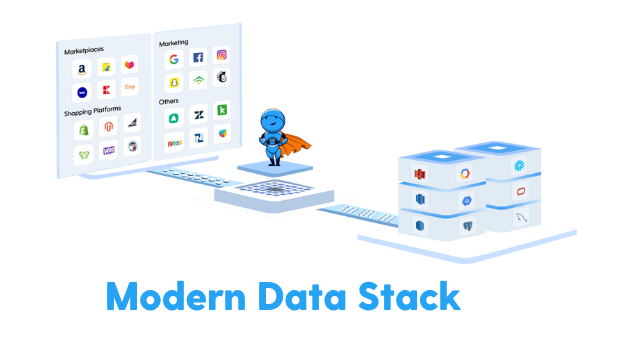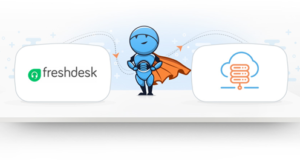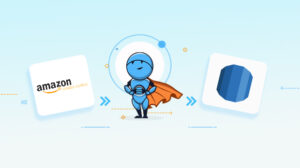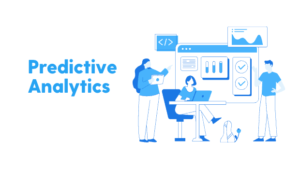What is a Data Stack
A data stack refers to the set of technologies and tools that organizations use to collect, store, process, analyze, and govern their data. The data stack can be thought of as the “infrastructure” that enables organizations to turn raw data into actionable insights.
A data stack typically includes technologies and tools for data management, data warehousing, data governance, data analytics, data engineering, data science, data security and business intelligence. These components can include various software, platforms and technologies, such as:
- Data management: databases, data lakes, data pipelines, data integration tools, etc.
- Data warehousing: data warehousing platforms, ETL (extract, transform, load) tools, columnar databases, data marts, etc.
- Data governance: data quality tools, data catalogs, data lineage tools, etc.
- Data analytics: data visualization tools, data mining software, predictive analytics software, machine learning platforms, etc.
- Data engineering: data integration tools, data pipelines, data processing frameworks, data warehousing platforms, etc.
- Data science: machine learning libraries, natural language processing libraries, data visualization libraries, etc.
- Data security: data encryption tools, data masking tools, data access controls, data monitoring and auditing tools, etc.
- Business intelligence: business intelligence platforms, data visualization tools, data mining software, etc.
For these components, there can be specific stacks as well, for e.g.:
| Stack Type | Description | Typical Components |
| Big Data Stack | Technologies and tools used to manage, store and analyze large volumes of data | Hadoop, Spark, NoSQL databases, data visualization and analytics tools |
| Cloud Data Stack | Technologies and tools used to manage, store and analyze data in the cloud | Cloud-based data storage and processing services, data visualization and analytics tools that can be run in the cloud |
| Data Governance Stack | Technologies and tools used to ensure the accuracy, security, and compliance of data | Data quality tools, data catalogs, data lineage tools, data access controls, data monitoring and auditing tools |
| Data Analytics Stack | Technologies and tools used to extract insights from data | Data visualization tools, data mining software, predictive analytics software, machine learning platforms |
| Data Warehousing Stack | Technologies and tools used to manage and analyze large volumes of data | Data warehousing platforms, ETL tools, columnar databases, data marts |
| Data Engineering Stack | Technologies and tools used to collect, store, and process data at scale | Data integration tools, data pipelines, data processing frameworks, data warehousing platforms |
| Data Science Stack | Technologies and tools used in data science | Machine learning libraries, natural language processing libraries, data visualization libraries |
| Data Security Stack | Technologies and tools used to protect data from cyber threats and ensure compliance with industry regulations | Data encryption tools, data masking tools, data access controls, data monitoring and auditing tools |
| Business Intelligence Stack | Technologies and tools used to turn data into insights and drive better business decisions | Business intelligence platforms, data visualization tools, data mining software |
Legacy vs Modern Data Stack
Legacy data stacks refer to the older systems or technologies that were used to manage data in the past. These systems may be based on older technology or architecture and may not be able to handle the volume, variety, and velocity of data that modern organizations generate and process. They may also lack the scalability, flexibility, and security that are required to meet the needs of modern businesses.
Modern data stacks, on the other hand, are built using newer technology and architecture that are designed to handle the scale and complexity of modern data. They often make use of cloud-based services, distributed systems, and open-source technologies to provide scalability, flexibility, and cost-effectiveness. Modern data stacks are also designed to be more secure and to support real-time data processing and analytics.
Modern data stack also makes use of open source technologies, that often allows to build and customize your stack as per your need, include data integration, data processing, data storage, data governance, data discovery, data visualization, and machine learning platforms. They also empower data-driven decision making and the ability to extract insights.
Here is a comparison table between legacy and modern data stacks:
| Feature | Legacy Data Stack | Modern Data Stack |
| Architecture | Monolithic | Distributed, cloud-native |
| Scalability | Limited | High |
| Data processing | Batch-based | Real-time, stream-based |
| Data storage | Relational databases | Multi-model databases, data lake |
| Data governance | Ad-hoc, manual | Automated, policy-driven |
| Data integration | Custom-built, manual | Automated, API-based |
| Data discovery & visualization | Basic, static | Interactive, dynamic |
| Security | Basic, reactive | Advanced, proactive |
| Flexibility | Limited | High |
| Data science & machine learning | Basic | Advanced |
It’s important to notice that the distinction between legacy and modern data stacks is not always clear-cut, and the boundary between them can vary depending on the organization. Some organizations may have modernized parts of their data stack while maintaining legacy systems in other parts, while others may be in the process of transitioning from a legacy data stack to a modern one.
10 Advantages and Benefits of Modern Data Stacks
Modern data stacks, which are built using newer technologies, have several advantages over traditional data stacks. 10 advantages of modern data stacks include:
- Cloud-native: Modern data stacks are designed to be cloud-native, which means they are built to be run on cloud computing platforms. This allows for easy scalability, as well as cost savings by only paying for the resources you need.
- Automation: Many modern data stacks include automation tools that can help to streamline data processing and make it easier to manage large amounts of data.
- Real-time data processing: Modern data stacks often include technologies specifically designed for real-time data processing, such as streaming platforms and real-time analytics databases, which allow for faster and more accurate data analysis.
- Big Data: Modern data stacks are designed to handle Big data, which is a term for datasets that are so large or complex that traditional data processing tools are inadequate.
- Multi-structured data: Modern data stacks are built to handle a variety of data types, including structured, semi-structured, and unstructured data, making it possible to store and analyze data from a wide range of sources.
- Ease of use: The user interface, data pipeline abstraction and other toolkits in modern data stacks are designed to be user-friendly, making it easier for data analysts, engineers and scientists to work with them. Scalability: Modern data stacks are designed to handle large volumes of data, and they can easily scale up or down to meet changing business needs. This is often achieved through the use of distributed systems and cloud-based services.
- Multi-model data storage: Modern data stacks support different types of data storage models, such as relational databases, document databases, graph databases, key-value databases, object databases. This allows organizations to choose the best storage option for their data, depending on the specific use case.
- Automated data governance: Modern data stacks provide automated data governance capabilities, such as data lineage, data cataloging, data lineage, metadata management, that allow organizations to manage and control their data effectively.
- Advanced data analytics: Modern data stacks provide advanced analytics tools and techniques, such as machine learning and natural language processing, which allow organizations to extract valuable insights from their data.
- Advanced security: Modern data stacks have advanced security features built-in such as data encryption, authentication, access control, threat detection, and incident management. This helps organizations to protect their data from unauthorized access and breaches.
Components of a Modern Data Stack
The six main components of a data stack are:
- Data Integration
- Data Storage
- Data Processing
- Data Analysis
- Data Visualization
- Data Governance and Management
| Data Stack Layer | Description | Examples |
| Data Integration | Technologies and tools used to collect and ingest data from various sources | Daton, AWS Kinesis, Logstash |
| Data Storage | Databases and other storage systems used to store data in a structured or unstructured format. Data modeling is closely tied to this layer, as the data model defines the structure of the data that is stored in these systems. | MySQL, PostgreSQL, MongoDB, Cassandra, AWS S3, Google Cloud Storage |
| Data Processing | Technologies and tools used to process and clean data | Apache Spark, Hadoop |
| Data Analysis | Tools and technologies used to analyze and extract insights from data | Machine learning platforms like TensorFlow and PyTorch or Python. SQL |
| Data Visualization | Tools and technologies used to display data in an easy-to-understand format | Power BI, Excel, Google Data Studio |
| Data Governance | Technologies and tools that help organizations manage and govern their data | Collibra, Informatica, Alation |
Data Collection Layer
This includes technologies and tools used to gather data from various sources, such as ELT tools, APIs, IoT devices, web scraping and databases.
| Data Collection Method | Salient Points | ELT/ETL Tools |
| Web scraping | Automated extraction of data from websites | BeautifulSoup, Scrapy, Parsehub |
| APIs | Programmatic access to data from external systems | Daton, RapidAPI, Talend |
| Database exports | Extracting data from a database and exporting it in a specific format | MySQL, SQL Server Management Studio, Oracle SQL Developer |
| Excel/CSV files | Extracting data from spreadsheet files | Microsoft Excel, OpenOffice Calc, Google Sheets |
| Log files | Extracting data from log files generated by various systems | Logstash, Flume, Fluentd |
| Social media data | Extracting data from social media platforms (e.g. tweets, posts, etc.) | Hootsuite Insights, Brandwatch, Crimson Hexagon |
Data Storage Layer
This includes technologies and tools used to store data, such as relational databases (e.g. MySQL, PostgreSQL), non-relational databases (e.g. MongoDB, Cassandra), data warehouse (e.g. Amazon Redshift, Google BigQuery) and cloud storage solutions (e.g. Amazon S3, Google Cloud Storage).
| Storage Option | Benefits | Trade-offs |
| Relational databases (e.g. MySQL, PostgreSQL) | Support structured queries using SQL, designed to ensure data integrity and consistency. | May be less performant at scale, and may require more complex setup and maintenance. |
| Non-relational databases (e.g. MongoDB, Cassandra) | More performant at scale and can be more efficient for certain use cases, such as storing large amounts of unstructured data. | Lack the robust querying capabilities of relational databases and may not be as good at ensuring data integrity and consistency. |
| Data warehouse (e.g. Amazon Redshift, Google BigQuery) | Designed for data warehousing and business intelligence (BI) workloads, allows for storing and querying large amounts of historical data, and support complex aggregate queries. | More expensive in terms of licensing and maintenance costs, and may be less performant with high write loads. |
| Cloud storage (e.g. Amazon S3, Google Cloud Storage) | Can be highly scalable and allows for easy access to data from anywhere. | Can be more expensive than other storage options, and may require more complex security and compliance considerations. |
| Distributed File Systems (e.g HDFS, GlusterFS) | High availability and data replication, support very large files and directories, well suited for big data and batch processing workloads | Require more complex setup and maintenance, and may not support real-time data access or transactional workloads |
Also, read:
Data Processing Layer
This includes technologies and tools used to process and transform data, such as Apache Hadoop and Apache Spark.
| Data Processing Technology | Salient Points |
| Hadoop | Distributed data processing framework for big data |
| Spark | In-memory data processing framework for big data |
| Storm | Real-time data processing framework for streaming data |
| Flink | Distributed data processing framework for streaming and batch data |
| Kafka | Distributed data streaming platform |
| NiFi | Platform for dataflow management and data integration |
| SQL | declarative programming language to interact and manage relational databases |
| Dataflow | Fully-managed service for creating data processing pipelines |
| Airflow | Open-source platform to create, schedule, and monitor data pipelines |
| AWS Glue | Serverless extract, transform, and load (ETL) service |
| Azure Data Factory | Cloud-based data integration service |
| Google Cloud Dataflow | Cloud-based data processing service |
Data Analysis Layer
This includes technologies and tools used to analyze and gain insights from data, such as SQL, Python libraries for data analysis (e.g. Pandas, NumPy), and business intelligence (BI) tools (e.g. Tableau, Looker).
| Data Analysis Technology | Salient Points |
| R | Open-source programming language for data analysis and visualization |
| Python | General-purpose programming language for data analysis and machine learning |
| SAS | Suite of software for data analysis, business intelligence, and predictive analytics |
| MATLAB | Programming language and environment for numerical computation and visualization |
| Tableau | Data visualization tool that allows users to create interactive dashboards and charts |
| Excel | Spreadsheet software that can be used for basic data analysis and visualization |
| SQL | Declarative programming language used to extract, analyze and query data from relational databases |
| Power BI | Data visualization and business intelligence tool from Microsoft |
| Looker | Data visualization and exploration platform |
| Google Analytics | Web analytics service that tracks and reports website traffic |
| BigQuery | Cloud-based big data analytics web service from Google |
Also, read:
- eCommerce Analytics
- Marketing Analytics
- Real time Analytics
- Customer Analytics
- Subscription Analytics
Data Visualization Layer
This includes technologies and tools used to create visualizations and dashboards, such as Tableau, D3.js, matplotlib, ggplot2 and others.
| Technology | Description |
| Matplotlib | A plotting library for the Python programming language. Often used for basic plots and charts. |
| Seaborn | A data visualization library based on Matplotlib. Provides more advanced visualization options and a more attractive default style. |
| Plotly | A library for creating interactive, web-based plots and charts. Can be used with Python, R, or JavaScript. |
| Bokeh | A library for creating interactive, web-based plots and charts similar to Plotly. Focused on providing a smooth user experience. |
| ggplot2 | A plotting library for the R programming language, based on the grammar of graphics. Provides a high-level interface for creating plots and charts. |
| D3.js | A JavaScript library for creating interactive, web-based data visualizations. Often used for more complex visualizations, such as network diagrams and maps. |
| Tableau | A commercial data visualization tool that allows users to create interactive, web-based visualizations without coding. |
| Power BI | A commercial data visualization and business intelligence tool developed by Microsoft. Allows for easy creation of interactive dashboards and reports. |
| Looker | A Business Intelligence and Data visualization tool which offers an easy way to create and share interactive and insightful data visualizations. |
| Apache Superset | An open-source business intelligence web application to create and share data visualizations, it has a simple and intuitive UI, SQL Lab, and support for a wide range of databases. |
Data Governance & Management Layer
This includes technologies and tools used to manage and govern data, such as data cataloging, data lineage, data quality and metadata management.
| Component | Description | Considerations |
| Data Governance Framework | A set of guidelines and processes that govern how data is collected, stored, and used within an organization. | – Align with overall business strategy and goals.
– Clearly define roles and responsibilities for data governance. – Regularly review and update the framework to stay current with industry best practices and regulations. |
| Data Governance Team | A dedicated group of individuals responsible for implementing and maintaining the data governance framework. | – Comprise of representatives from different departments and levels within the organization.
– Ensure team members have the necessary skills and expertise. – Provide regular training and development opportunities for team members. |
| Data Management Policy | A set of rules and procedures for how data is collected, stored, and used within the organization. | – Clearly outline the type of data that is collected and how it is used.
– Address data security and privacy concerns. – Regularly review and update the policy to stay current with industry best practices and regulations. |
| Data Quality | The degree to which data meets the requirements set out in the data governance framework and data management policy. | – Establish processes for monitoring and improving data quality.
– Implement data validation and cleaning procedures to ensure accuracy and completeness. – Regularly review and update the data quality procedures. |
| Data Security | Measures put in place to protect data from unauthorized access, use, or disclosure. | – Implement appropriate security controls, such as encryption and access controls, to protect data at rest and in transit.
– Regularly monitor and review the security of data to detect and respond to potential security breaches. – Train employees on data security best practices. |
| Data Privacy | Procedures for protecting personal data and ensuring compliance with relevant regulations, such as GDPR. | – Regularly review and update data privacy procedures to stay current with industry best practices and regulations.
– Train employees on data privacy best practices. – Implement appropriate technical and organizational measures to protect personal data, such as pseudonymization and access controls. |
It’s worth noting that there are many other tools and technologies available for each layer of the data stack, and the specific components of a data stack will depend on the specific needs of the organization.
Building a Modern Data Stack
Building a modern data stack typically involves several steps, including data ingestion, storage, processing, and visualization. Here’s a general outline of how to start building a modern data stack:
- Identify the sources of data that you need to collect and store. This may include log files, application data, sensor data, and other sources. Read more – eCommerce data sources
- Choose a data storage solution that can handle the scale, performance, and reliability requirements of your data. Common options include relational databases, NoSQL databases, data warehousing solutions, and data lakes. Read more – data warehouse vs data lake
- Design an efficient data pipeline that can collect and process the data in real-time or near-real-time. This typically involves using tools such as Apache Kafka, Apache NiFi, or AWS Kinesis for data ingestion, and Apache Spark, Apache Storm, or Apache Flink for data processing.
- Choose a data visualization tool or platform that can help you explore and analyze the data. Some popular options include Tableau, Power BI, Looker, and Grafana.
- Implement robust data governance and security controls to ensure that your data is protected and that you are in compliance with any relevant regulations.
- Monitor and troubleshoot the data stack, and continuously optimize its performance and efficiency.
It’s worth to note that, the choice of technologies will depend on your specific use case, budget, team and the ecosystem you are using and the need for scalability.
Technical and architectural expertise required for building a data stack
- Experience with database management systems and SQL
- Knowledge of data warehousing concepts and techniques
- Familiarity with data modeling and ETL (extract, transform, load) processes
- Understanding of distributed systems and data pipelines
- Knowledge of cloud computing platforms (such as AWS, GCP, or Azure) and their various data storage and processing services
- Familiarity with big data technologies (such as Hadoop and Spark) and NoSQL databases
- Proficiency in at least one programming language, such as Python or Java, for writing scripts to automate ETL processes and data pipeline
- Familiarity with data governance, security, and compliance best practices.
11 Tips and Best Practices for Building and Maintaining a Data Stack
- Start by defining the data requirements and objectives of the organization
- Plan and design the data stack architecture to align with the organization’s data requirements and objectives
- Implement Data Governance and management, ensure that it is easy to track and manage your data
- Evaluate and select the right combination of data storage, processing, and analytics technologies to fit the organization’s needs
- Build data pipelines to efficiently move and process data through the stack
- Continuously monitor and optimize performance of the data stack to ensure data is accurate, consistent, and available
- Test and deploy the data stack in a structured and controlled manner
- Ensure that security and compliance are integrated into the data stack from the start
- Have a data disaster recovery plan in place
- Keep the stack updated and maintain it with regular upgrade and patching schedule
- Make sure to have good logging and monitoring in place for troubleshooting.
Examples of Data Stacks in Various Industries
Here are a few examples of data stacks in various industries:
- eCommerce: A data stack for an e-commerce company might include technologies such as a data warehouse (such as Amazon Redshift or Google BigQuery), an ELT tool (such as Daton) for extracting data from various sources and transforming it into a consistent format, and a business intelligence tool (such as Tableau or Looker) for analyzing and visualizing the data.
- Healthcare: A data stack for a healthcare company might include technologies such as a data lake (such as Amazon S3 or Microsoft Azure Data Lake) for storing and processing large amounts of medical data, a medical imaging platform (such as Horos or OsiriX) for processing and analyzing medical images, and a clinical data management system (such as OpenClinica or Medidata Rave) for collecting and managing clinical trial data.
- Advertising: A data stack for an advertising company might include technologies such as a real-time data processing platform (such as Apache Kafka or Google Cloud Dataflow) for ingesting and processing large amounts of data in real time, a data warehouse (such as Amazon Redshift or Google BigQuery) for storing and querying the data, and a predictive modeling platform (such as TensorFlow or H2O.ai) for building and deploying machine learning models.
- Finance: A data stack for a finance company might include technologies such as a data lake for storing and processing large amounts of financial data, a real-time data processing platform for ingesting and processing financial data streams, and a fraud detection platform (such as Kount or Feedzai) for identifying and preventing fraud.
- Automotive: A data stack for an automotive company might include technologies such as a data lake to store and process large amounts of sensor data, real-time data processing tools like Apache Kafka or Google Cloud Dataflow, and a machine learning platform such as TensorFlow or H2O.ai to build models and process predictions on the fly.
Note that this is not an exhaustive list, and that different companies in the same industry may use different technologies depending on their specific needs and resources.
Let’s look deeper into a modern data stack for eCommerce and retail.
Modern Data Stack for eCommerce and Retail
|
Component |
Tool/Platform |
Use Cases |
| Data Warehousing | Redshift, BigQuery, Snowflake | Storing and analyzing large amounts of customer, sales, and product data to understand purchasing patterns and identify key trends and opportunities. |
| Data Pipeline | Daton | Collecting real-time data from various sources such as web logs, social media, and point-of-sale systems, transforming and cleaning it, then loading it into the data warehouse for analysis. |
| Data Visualization | Tableau, Looker, Power BI | Creating interactive dashboards to track key metrics such as website traffic, sales, and customer behavior, and identify areas for improvement. |
| Data Modeling | ERD, Star schema, Snowflake schema | Structuring the data in the data warehouse to support efficient querying and analysis, such as breaking out sales data by product, location, and time period. |
| Business Intelligence | Tableau, PowerBI, QlikView, SAP BusinessObjects | Analyzing customer data to segment and target specific groups of customers, forecasting sales and inventory needs, and identifying opportunities for cross-selling and upselling |
Conclusion
In conclusion, a modern data stack is essential for businesses to collect, store, process, model, visualize, and analyze their data in order to gain valuable insights and drive growth. It typically involves several key components such as data collection, storage, processing, modeling, visualization, and business intelligence.
Saras Analytics has a team of experts who have set up data foundation for hundreds of eCommerce brands. With our expertise in data engineering and analytics, we can help you set up a modern data stack that is tailored to your specific business needs and goals.
If you’re interested in setting up a modern data stack for your eCommerce or retail business, please don’t hesitate to contact us for a consultation. Our team will work with you end-to-end to set up the data foundation that will help you gain valuable insights and drive growth.













